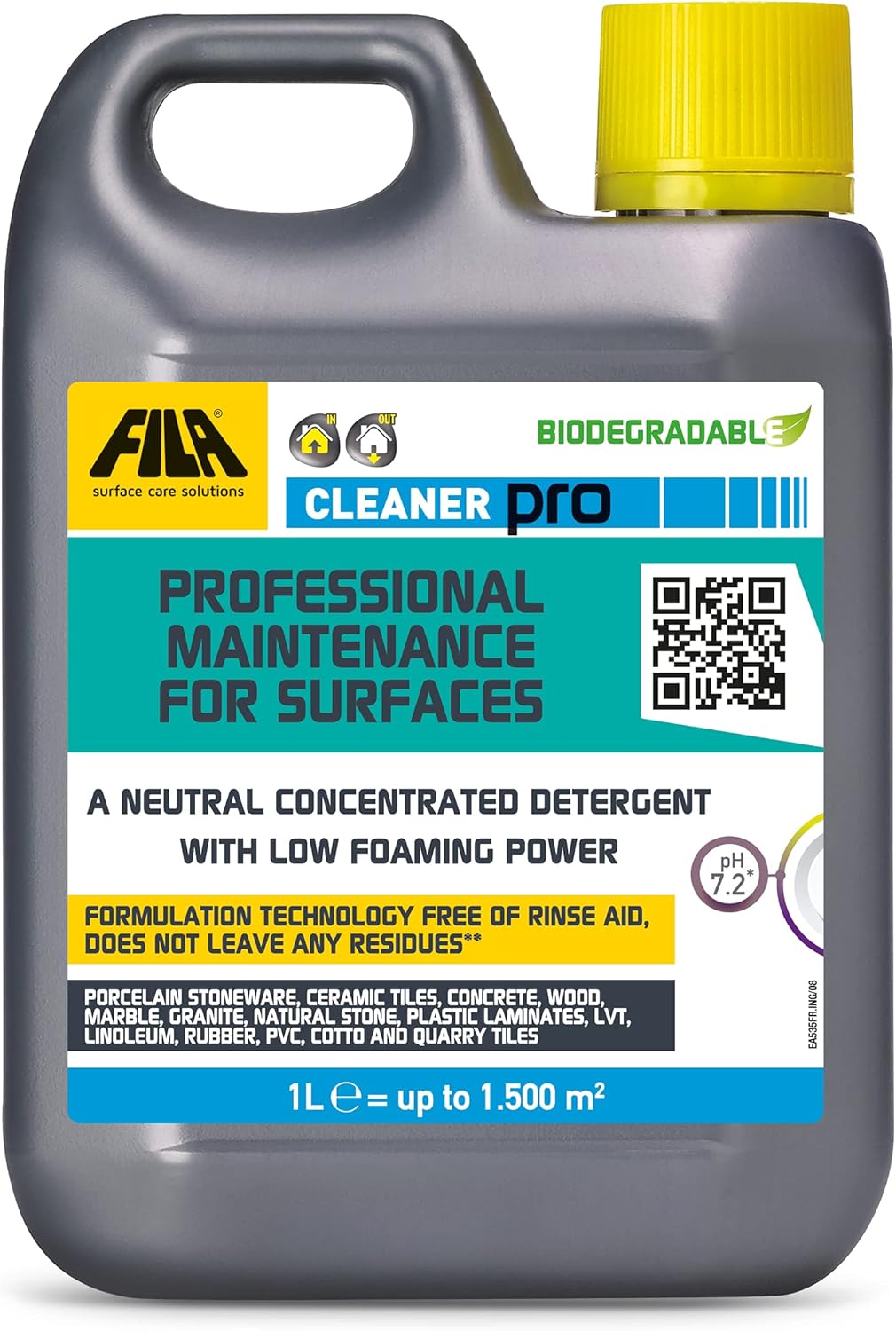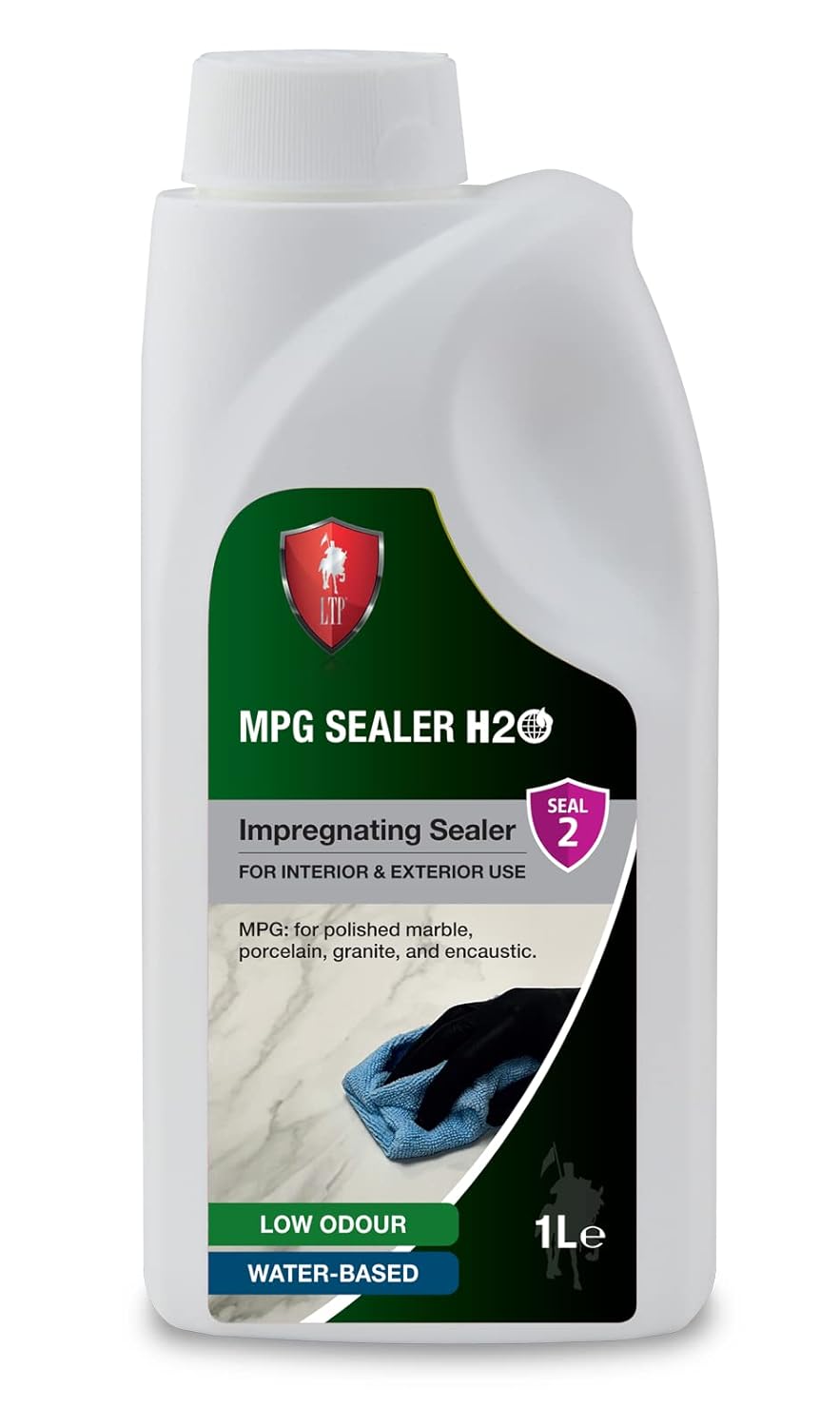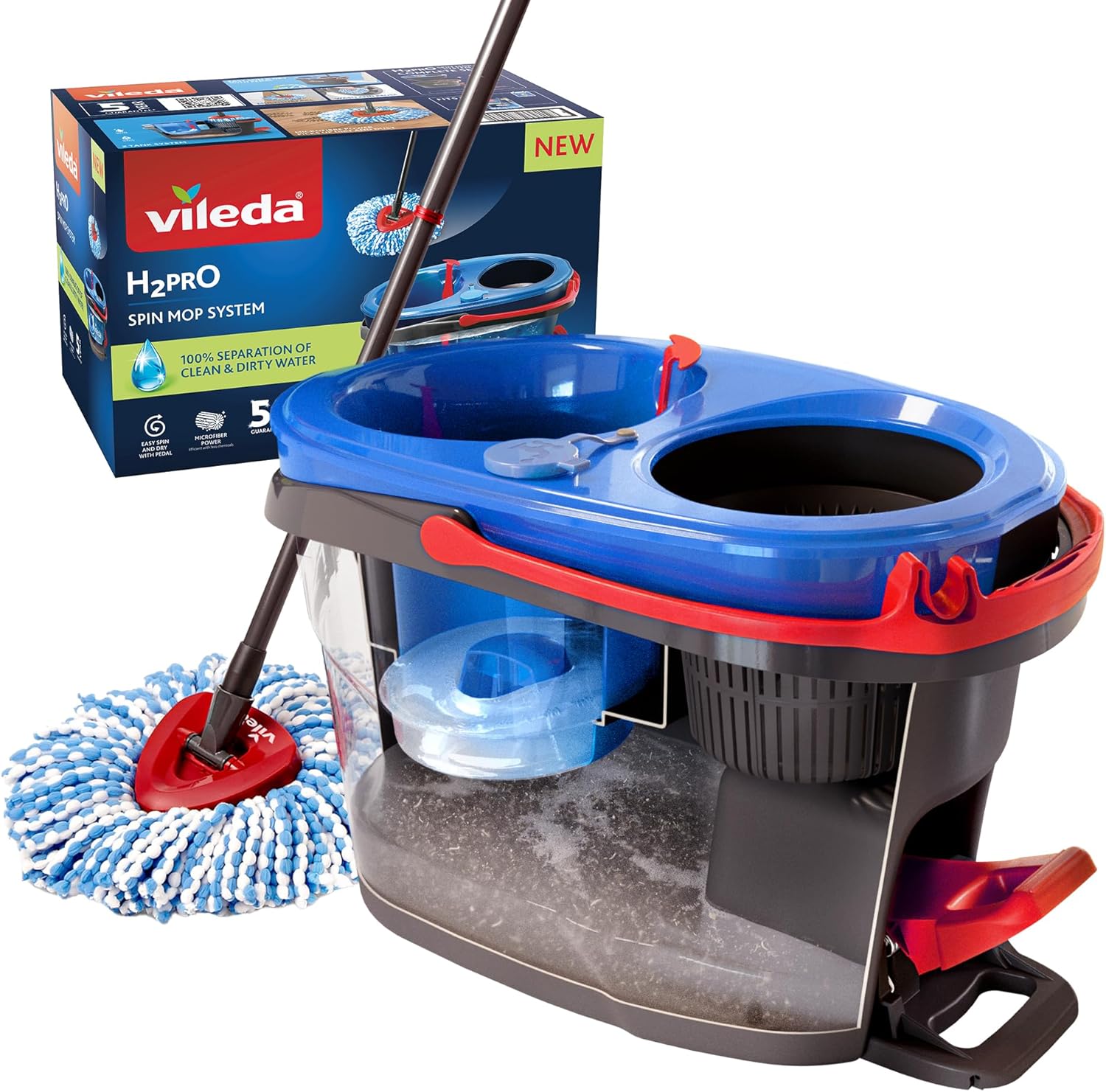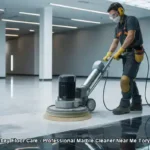
Last Updated on November 12, 2025 by David
Key takeaways from the article, “What Is the Best Product for Terrazzo Cleaning?”
- Use pH-neutral cleaners for routine care to avoid etching or dulling the surface, especially when marble chips are present in the terrazzo mix.
- Alkaline cleaners are suitable for ingrained soils, but must be rinsed thoroughly and resealed if left to dwell for extended periods.
- <a href="https://www.abbeyfloorcare.co.uk/home-garden/tile-care/restoring-colour-and-pigment-to-faded-victorian-mosaic-tiles/">Avoid acidic, bleach-based, or abrasive products</a>, as these can permanently damage terrazzo and compromise its long-term appearance.
- Topical sealers are a valid option when properly maintained and topped up, offering enhanced gloss and protection for high-traffic areas.
- Regular maintenance with soft tools and prompt spill response helps preserve the finish and reduce the need for frequent deep cleaning.
Comprehensively Exploring Terrazzo Floors and Their Unique Characteristics

What is Terrazzo Made Of? Discover the Components of This Unique Flooring
Terrazzo is a composite flooring material made by mixing marble, quartz, granite, or glass chips into a cement or epoxy base. Once laid, the surface is ground down and polished to create a smooth, decorative finish. Because it contains natural stone, terrazzo is sensitive to harsh chemicals and needs gentle care to stay looking its best. Understanding the components of terrazzo is essential for homeowners to appreciate the maintenance it requires.
Pro Tip: We recommend these products for daily Terrazzo maintenance cleaning.

Fila Pro Floor Cleaner
|

LTP MPG Sealer H20
|

Vileda H2PrO Spin Mop System
|
Why Terrazzo Needs Special Care: Understanding Its Sensitivity
Unlike ceramic or vinyl floors, terrazzo is porous and can absorb liquids if not properly sealed. Acidic cleaners, bleach, or abrasive tools can dull the surface or cause permanent staining. To keep terrazzo floors in good condition, it’s essential to use pH-neutral products designed for stone surfaces. Regular maintenance helps preserve the shine and prevents long-term damage, ensuring the beauty and longevity of your floors.
Avoiding Common Cleaning Mistakes for Terrazzo Floors

Why Acidic Cleaners Are a Risk: The Dangers of Using Them
Acid-based products such as vinegar, lemon juice, or lime scale removers can etch terrazzo surfaces, especially if they contain marble chips. Even a single application may leave dull patches or cause irreversible damage. Homeowners often assume natural acids are safe, but terrazzo reacts differently than ceramic or porcelain tiles. Understanding these risks is crucial for maintaining the integrity of your terrazzo floors.
The Problem with Steam and Bleach: Risks to Terrazzo Floors
Steam cleaners may seem convenient, but the high temperature and pressure can weaken sealants and drive moisture into the substrate. Bleach, on the other hand, is alkaline and can discolour terrazzo over time. Both methods risk undermining the integrity of the floor, especially in older properties or areas with worn sealant. It is important to explore safer alternatives for cleaning terrazzo surfaces.
How Abrasives Can Ruin the Finish: Protecting Your Terrazzo
Scouring pads, gritty powders, or stiff brushes can scratch the polished surface of terrazzo. Once scratched, the floor loses its reflective quality and becomes harder to clean. For deep-cleaning, always use soft pads and non-abrasive tools designed for stone surfaces. Preserving the finish is key to long-term beauty and ease of maintenance, ensuring your terrazzo floors remain stunning for years.
Selecting the Right Deep-Cleaning Product: Understanding Your Options

What Makes a Cleaner Safe for Terrazzo? Identifying Safe Cleaning Solutions
Safe terrazzo cleaners are pH-neutral, non-acidic, and free from harsh solvents. Because terrazzo often contains marble chips, it reacts poorly to acidic or alkaline products. A balanced cleaner helps lift dirt without breaking down the surface or sealant. Look for labels that specify compatibility with natural stone or terrazzo.
In cases where terrazzo floors are heavily soiled—especially in kitchens, hallways, or commercial spaces—standard pH-neutral cleaners may not be powerful enough to break down ingrained grime. Over time, oils, grease, and tracked-in dirt can settle deep into the porous surface, particularly if the sealant has worn away, necessitating a more robust cleaning approach.
Why an Alkaline Cleaner Is Sometimes Necessary: When to Consider Stronger Solutions
Alkaline cleaners are designed to cut through organic soils, grease, and stubborn residues that neutral products can’t entirely remove. These solutions work by emulsifying contaminants, lifting them from the terrazzo’s pores so they can be rinsed away. For deeply embedded grime, a stronger alkaline formulation may be the only way to restore the floor’s original appearance, ensuring it looks its best.
Rinse Thoroughly to Prevent Surface Damage: Ensuring Proper Care
While effective, alkaline cleaners must be used with care. Leaving them on the surface too long can strip away protective sealers or cause discolouration. After the dwell time—typically 5 to 15 minutes—rinse the floor thoroughly with clean water. Use a wet vacuum or multiple mop passes to ensure no residue remains. Inadequate rinsing can lead to a chalky film or long-term dullness, impacting the overall aesthetic of your terrazzo floor.
Resealing May Be Required After Deep Alkaline Cleaning: Protecting Your Investment
If the cleaner needed extended dwell time to break down soils, or if the floor was already unsealed, it’s wise to reseal the terrazzo after cleaning. Alkaline products can open the stone’s pores, making it more vulnerable to future staining. Applying a breathable impregnating sealer helps restore protection and maintain the floor’s resistance to moisture and dirt, ensuring its longevity.
Your Comprehensive Guide to Deep-Cleaning Terrazzo Floors
Preparing the Surface: Getting Ready for Effective Cleaning
Start by removing loose dust and debris with a soft-bristle broom or a vacuum on the hard floor setting. Avoid dragging furniture or using metal-edged tools, as these can scratch the surface. If the floor has old polish or residue, consider using a safe terrazzo stripper before deep-cleaning to ensure optimal results.
Applying the Cleaner Safely: Ensuring Effective Application
Mix your chosen cleaner according to the manufacturer’s instructions. Apply it evenly across the floor using a microfiber mop or soft applicator. Let the solution dwell for 5 to 10 minutes to loosen embedded dirt, but do not allow it to dry on the surface. Work in manageable sections to maintain control and achieve thorough cleaning.
Agitation and Rinsing Techniques: Maximising Cleaning Effectiveness
Use a soft white pad or a slow-speed rotary machine with a non-abrasive brush to agitate the surface. This helps lift grime from the terrazzo’s pores without scratching. Rinse thoroughly with clean water, changing the water frequently to avoid re-depositing dirt. A wet vacuum can speed up the process and improve results, ensuring a pristine finish.
Drying and Buffing for a Lasting Finish: Achieving the Perfect Look
Allow the floor to air dry thoroughly or use a dry microfiber mop to remove residual moisture. Once dry, buff the surface with a clean white pad to restore a light sheen. If the floor still looks dull, it may be time to consider resealing or polishing, especially in high-traffic areas where wear is more noticeable.
Recognising When to Reseal Your Terrazzo Floor: Maintaining Longevity
Signs Your Seal Has Worn Off: Identifying the Need for Resealing
If your terrazzo floor looks dull, absorbs water quickly, or shows signs of staining, the sealant may have broken down. A simple water-drop test can help: place a few drops on the surface and observe. If the water darkens the stone or disappears within seconds, it’s time to reseal your terrazzo floors to protect them from further damage.
Choosing the Right Sealer: Ensuring Optimal Protection
For UK homes, solvent-based impregnating sealers such as Lithofin Stainstop or Fila MP90 offer long-lasting protection without altering appearance. These penetrate the surface, block moisture and stains, and do not form a visible layer. This ensures that your terrazzo maintains its natural beauty while being protected.
How to Apply Sealer at Home: A Step-by-Step Approach
Clean the floor thoroughly and allow it to dry for at least 24 hours. Apply the sealer evenly using a lint-free cloth or sponge, working in small sections to ensure full coverage. Let it absorb for the recommended time, then wipe off any excess. A second coat may be needed for high-traffic areas to ensure optimal protection. Always ventilate the space and follow safety instructions on the label to ensure safe application.
Effective Maintenance Strategies for Terrazzo After Deep Cleaning
Weekly and Monthly Maintenance Tips: Keeping Your Floors Pristine
To keep terrazzo looking its best, dry mop regularly with a microfiber pad to remove dust and grit. For weekly cleaning, use a diluted pH-neutral cleaner and avoid soaking the floor. Monthly, inspect high-traffic areas for wear and reapply cleaner as needed. Avoid over-wetting, which can weaken sealants over time and lead to further issues.
Best Mops and Tools for Ongoing Care: Selecting the Right Equipment
Microfiber mops are ideal for terrazzo because they trap fine particles without scratching the surface. Avoid sponge mops, which can push dirt into the pores. For larger areas, consider a spray mop with refillable cartridges that allow controlled application of stone-safe solutions. Always rinse mop heads thoroughly after use to prevent residue buildup, ensuring effective cleaning.
How to Handle Spills and Stains Quickly: Protecting Your Floors from Damage
Blot spills immediately using a soft cloth or paper towel. Do not rub, as this can spread the stain. For oily or coloured spills, apply a small amount of stone-safe cleaner and rinse with clean water. If a stain persists, use a baking soda and water poultice, but test first to ensure it won’t affect the finish. Timely action prevents permanent marks and keeps the floor looking fresh and inviting.
Common Queries Regarding Terrazzo Floor Cleaning: Your Questions Answered
Can I Use Vinegar on Terrazzo? Understanding the Risks
No. Vinegar is acidic and can etch terrazzo surfaces, especially if it contains marble chips. Even diluted vinegar can cause dull spots or long-term damage. Always choose a pH-neutral cleaner specifically formulated for stone surfaces to ensure the longevity of your terrazzo floors.
What If My Floor Is Already Damaged? Exploring Restoration Options
If your terrazzo has scratches, stains, or dull patches, deep-cleaning alone may not restore its appearance. You may need professional honing or polishing to remove surface damage. In some cases, resealing or applying a stone-safe polish can improve the look, but restoration is the best route for heavily worn floors, ensuring they look their best once again.
How Often Should I Deep-Clean? Recommendations for Regular Maintenance
For most UK homes, deep-cleaning terrazzo every 6 to 12 months is sufficient. High-traffic areas like hallways or kitchens may need more frequent attention. Regular maintenance between deep cleans helps extend the life of the sealant and keeps the floor looking fresh year-round, ensuring your terrazzo continues to shine.
The Article What Is the Best Product for Terrazzo Cleaning first found on https://www.abbeyfloorcare.co.uk

